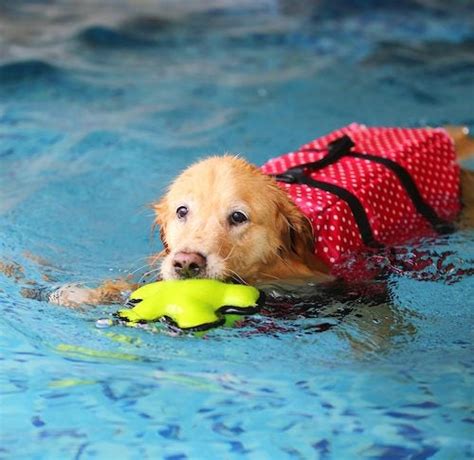Pet swimming and water therapy are two popular forms of exercise for dogs.
However, there are some key differences between the two.
Swimming is a great way to get your dog moving and burning off energy.
It is also a low-impact exercise, which makes it easy on your dog’s joints.
Water therapy is a form of rehabilitation that is used to help dogs with injuries or disabilities.
It can help dogs to improve their range of motion, strength, and coordination.

Swimming
Swimming is a great way to get your dog moving and burning off energy.
It is also a low-impact exercise, which makes it easy on your dog’s joints.
Swimming can be done in a pool, lake, or ocean.
If you are taking your dog swimming in a natural body of water, be sure to check for hazards such as sharp objects or strong currents.
Benefits of Swimming
- Burns off energy: Swimming is a great way to get your dog moving and burning off energy.
- Low-impact exercise: Swimming is a low-impact exercise, which makes it easy on your dog’s joints.
- Improves cardiovascular health: Swimming is a great way to improve your dog’s cardiovascular health.
- Reduces stress: Swimming can help to reduce stress in dogs.
Water Therapy
Water therapy is a form of rehabilitation that is used to help dogs with injuries or disabilities.
It can help dogs to improve their range of motion, strength, and coordination.
Water therapy is typically done in a pool or tank that is filled with warm water.
Benefits of Water Therapy
- Pain relief: Water therapy can help to relieve pain in dogs with injuries or disabilities.
- Improved range of motion: Water therapy can help to improve range of motion in dogs with injuries or disabilities.
- Increased strength: Water therapy can help to increase strength in dogs with injuries or disabilities.
- Improved coordination: Water therapy can help to improve coordination in dogs with injuries or disabilities.
Which is Right for Your Dog?
The best way to decide which form of exercise is right for your dog is to talk to your veterinarian.
Your veterinarian can help you to assess your dog’s individual needs and recommend the best course of action.
Tips for Keeping Your Dog Safe
Here are a few tips for keeping your dog safe while swimming or participating in water therapy:
- Never leave your dog unattended in water.
- Make sure your dog is wearing a life jacket if they are swimming in a pool or lake.
- Be aware of the water temperature and make sure it is not too cold or too hot for your dog.
- Rinse your dog off with fresh water after swimming to remove any chlorine or salt.
- If your dog has any injuries or disabilities, be sure to talk to your veterinarian before starting a swimming or water therapy program.
FAQs
1. How often should I take my dog swimming or water therapy?
The frequency with which you should take your dog swimming or water therapy will depend on your dog’s individual needs.
Your veterinarian can help you to determine the best schedule for your dog.
2. How long should I keep my dog in the water?
The length of time you should keep your dog in the water will depend on your dog’s individual needs and tolerance.
Start with short sessions and gradually increase the duration as your dog becomes more comfortable.
3. What are the signs that my dog is enjoying swimming or water therapy?
Some signs that your dog is enjoying swimming or water therapy include:
- Wagging their tail
- Swimming or paddling around
- Splashing and playing
- Looking relaxed and happy
4. What are the signs that my dog is not enjoying swimming or water therapy?
Some signs that your dog is not enjoying swimming or water therapy include:
- Whining or barking
- Trying to get out of the water
- Looking scared or stressed
5. What should I do if my dog is not enjoying swimming or water therapy?
If your dog is not enjoying swimming or water therapy, stop the activity and try something else.
There are many other ways to exercise your dog, such as walking, running, or playing fetch.
6. How much does swimming or water therapy cost?
The cost of swimming or water therapy will vary depending on the location and the type of facility.
Some facilities offer single sessions, while others offer packages or memberships.
Reviews
1. “My dog loves swimming! He gets so excited when we go to the pool. It’s a great way for him to burn off energy and have fun.”
2. “Water therapy has been a lifesaver for my dog. He has arthritis and it’s helped him to improve his range of motion and reduce his pain.”
3. “I’m so glad I found a facility that offers swimming and water therapy for dogs. It’s a great way to keep my dog active and healthy.”
4. “Swimming and water therapy are both great options for exercising your dog. Talk to your veterinarian to see which one is right for your dog.”
Market Insights
The market for pet swimming and water therapy is growing rapidly.
More and more pet owners are looking for ways to keep their pets active and healthy.
This is due in part to the increasing popularity of pet ownership and the growing awareness of the benefits of exercise for pets.
The market for pet swimming and water therapy is expected to continue to grow in the coming years.
This is due to the increasing popularity of pet ownership and the growing awareness of the benefits of exercise for pets.





















